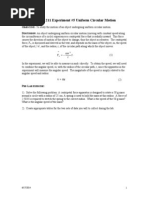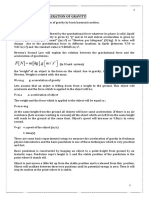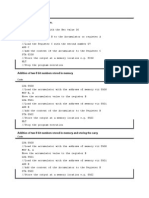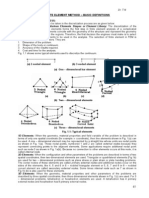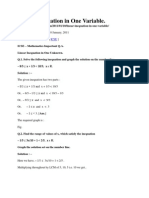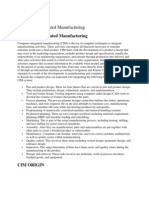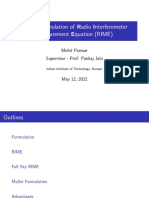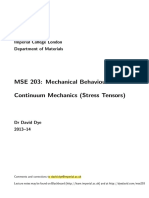FEM (Dynamic Analysis)
Uploaded by
Debasis SahaFEM (Dynamic Analysis)
Uploaded by
Debasis SahaDynamic Analysis
Equation of Motion:
Fig. 1: Body with distributed mass
Consider a solid body with distributed mass as shown in Fig. The displacements
w v u and ,
, stresses
and strains in x, y and z directions are all time depended in dynamic problems. The equation of motion
of the body is obtained by considering both kinetic and potential energies of the body.
The kinetic energy of body is gien by
V
T
dV u u T
!
"
where
# density $mass%unit olume& of the material
u # elocity ector at a point inside the body
'n F(), the entire body is subdiided into number of elements and in each element we express the
displacement u as
Nq u q N u
and hence,
T T T
N q u
*ubstituting into aboe equation, we get the +.( of an element as
,
_
e
V
e T
e
V
T T T T e
q M q q NdV N q dV q N N q T
!
"
!
"
!
"
where M
e
is consistent mass matrix.
The +.( of entire body is obtained by taking summation $i.e assembly& oer all the element and is gien
by
Q M Q T T
T
e
e
!
"
$a&
,e know that, the potential energy of entire body is gien by
F Q KQ Q
T T
!
"
$b&
Then, the equation of motion is obtained by using -agrange equation gien by
.
,
_
Q
L
Q
L
dt
d
$c&
where, T L . *ubstituting of T and from (qn. $a& and $b&, we get
F Q KQ Q Q M Q L
T T T
+
!
"
!
"
Q M
Q
L
( ) Q M Q M
dt
d
Q
L
dt
d
,
_
and
F KQ
Q
L
+
substitute into (qn. $c&, we get
. & $ + F KQ Q M
or F KQ Q M +
For a free ibration of body, . F , then the aboe equation reduces to
. +KQ Q M
$d&
(qn. $d& is equation of motion of body for the free ibration.
Evaluation of Eigen alues and ectors:
,e hae equation of motion of free ibration of body as
. +KQ Q M
$a&
-et the solution of the aboe equation be
t X Q sin
t X Q cos
and t X Q sin
!
sub. 'nto (qn $a&, we get
. sin sin
!
+ t KX t MX
MX KX
!
or MX KX where,
!
$b&
(qn $b& is the expression for eigen alue problem.
(qn.$b& can also be written as
[ ]{ } . X M K $c&
where X is the eigen ector corresponding to the eigen alue .
'f the eigen ector to be nontriial, the required condition is
. M K
$d&
(qn. $d& represents characteristic equation in . *olutions of characteristic equation are the eigen
alues.
For each (igen alue
& , ! , " $ n i
i
there is an (igen ector
i
X
obtained from (qn. $c&.
Then, (qn. $c& is expressed as
[ ]{ } .
i
i
X M K
Derivation of Element Mass Matrices:
!a" For a #$noded bar element:
'n general, the kinetic energy of an
th
e
element can be written as
e
V
e e
T e
dV u u T
!
"
///$a&
The field ariable at any point inside the element is expressed as
Nq u
Therefore, its deriatie w.r.t time, t is written as
q N u
T T T
N q u
*ubstitute into (q, $a&, we get
q NdV N q dV q N N q T
e
V
e
T
e
T
e
V
e e
T T e
,
_
!
"
!
"
q M q T
e T e
!
"
///$b&
where,
e
V
e
T
e
e
NdV N M
is the element mass matrix ///$c&
For a !/noded bar element shown in Fig, we hae,
dx A dV
e e
"
!
. x
e
l x
"
u
!
u
& $x P
e
l
Consider a !/noded bar element as shown in fig, -et u
and
u
!
be the nodal displacements. Treating the material
density,
$kg%m
0
& to be constant oer the element, the
element mass matrix can be obtained from the kinetic
energy functional as follows.
e
{ }
! "
u u q
T
and [ ]
! "
N N N
[ ]
1
1
]
1
'
!
! ! "
! "
!
"
! "
!
"
N N N
N N N
N N
N
N
N N
T
*ubstitute into (q. $c&, we get
dx
N N N
N N N
A M
e
l
e e
e
1
1
]
1
.
!
! ! "
! "
!
"
///$d&
'ntegration of (q. $d& can be carried out using the following integration rule,
e e
e
l
e
l
l l dx N dx N
1
!
&2 " ! $
2 !
!
!
!
"
+
and
e e
e
l
l l dx N N
1
"
& " " " $
2 " 2 "
! "
+ +
*ubstitution of aboe integrals into each term of (q. $d& yields mass matrix for a !/noded bar element as
1
]
1
! "
" !
1
e e e e
l A
M
!b" For a %russ element:
Proceed same as case "a#and show that
e
V
e
T
e
e
NdV N M
///$c&
For a truss element shown in Fig, we hae x d A dV
e e
3 { }
! ! " "
v u v u q
T
and
1
]
1
! "
! "
. .
. .
N N
N N
N $see note below&
&ote: For a truss element we hae
! ! " "
u N u N u + and
! ! " "
v N v N v +
Nq
v
u
v
u
N N
N N
v
u
u
'
1
]
1
'
!
!
"
"
! "
! "
. .
. .
1
1
1
1
1
]
1
1
]
1
1
1
1
1
]
1
! ! "
!
! ! "
! "
!
"
! "
!
"
! "
! "
!
!
"
"
. .
. .
. .
. .
. .
. .
.
.
.
.
N N N
N N N
N N N
N N N
N N
N N
N
N
N
N
N N
T
///$d&
*ubstitute into (q. $c& and carryout integration of each term using the following rule, we get mass matrix
for truss element.
Consider a !/noded truss element as shown in fig. The truss
element can be considered as a bar along its local
coordinate x . -et u
,
v
and u
!
, v
!
be the nodal
displacements in x and y / directions. Treating the material
density,
$kg%m
0
& to be constant oer the element, the
element mass matrix can be obtained from the kinetic
energy functional as follows.
e
"
!
"
u
!
u
"
v
!
v
%russ Element
e e
e
l
e
l
l l dx N dx N
1
!
&2 " ! $
2 !
!
!
!
"
+
and
e e
e
l
l l dx N N
1
"
& " " " $
2 " 2 "
! "
+ +
The resulting mass matrix is
1
1
1
1
]
1
! . " .
. ! . "
" . ! .
. " . !
1
e e e e
l A
M
!c" For a Beam element:
Proceed same as case "a# and show that
e
V
e
T
e
e
NdV N M
///$c&
4ow, for beam element, we hae
dx A dV
e e
3 { }
! ! " "
w w q
T
and
[ ]
5 0 ! "
N N N N N
1
1
1
1
1
]
1
!
5
5 0
!
0
5 ! 0 !
!
!
5 " 0 " ! "
!
"
N
N N N
N N N N N
N N N N N N N
N N
T
///$d&
where, the shape functions for beam element are expressed in cartesian coordinate system as
0
0
!
!
"
! 0
"
e e
l
x
l
x
N +
;
!
0 !
!
!
e e
l
x
l
x
x N +
--- (e)
0
0
!
!
0
! 0
e e
l
x
l
x
N
;
!
0 !
5
e e
l
x
l
x
N +
*ubstitution of (qs. $d& and $e& into (q. $c& and integration of the resulting equation yields the
mass matrix for beam element as
1
1
1
1
]
1
!
! !
5
!! "61 .
0 "0 5
"0 65 !! "61
5!.
e
e
e e e
e e
e e e e
l
l $%mm
l l l
l l
l A
M
&ote: The integration rule used in the preious cases is applicable only for the bar element and
hence it cannot be used for beam element.
'onsistent mass matri(: The element mass matrix obtained by the relation
e
T e
NdV N M
is called consistent mass matrix. 't is termed consistent because the same shape functions 4 are
used to formulate the stiffness and mass matrices. For the !/noded bar element, as an example,
the consistent mass matrix is expressed as,
1
]
1
! "
" !
1
e e e e
l A
M
" !
. x
e
l x
"
e
l
"
w
"
Consider a !/noded beam element as shown in Fig. -et
" "
, w
and
! !
, w
be the nodal deflection and slope
at node " and ! respectiely. Treating the material
density,
$kg%m
0
& to be constant oer the element,
the element mass matrix can be obtained from the
kinetic energy functional as follows.
)um*ed mass matri(: The lumped mass matrix is obtained by equally placing the total mass of
the element at the nodes of the element. Then, the resulting lumped mass matrix is diagonal. For
a !/noded bar element, it is expressed as
1
]
1
" .
. "
!
e e e e
l A
M
.
'onsistent masses v+s )um*ed masses: The lumped masses proide some significant
economies compared to consistent masses. The diagonal lumped mass matrix requires less
storage space than the banded consistent mass matrix. The diagonal lumped form greatly
simplify the matrix calculation, it reduces the number of equations occurring in the dynamic
problem. 7oweer, the mode shapes obtained using lumped mass matrix are less reliable and
consistent mass matrix proides more accurate mode shapes and the natural frequencies than the
lumped mass matrix.
,ro*erties of Eigenvectors:
The (igenectors hae the following properties8
". For a positie definite symmetric stiffness matrix of size $4x4&, there are 4 number of real
&i'envalues and corres(ondin' &i'envectors satisfying the equation $(q. 0.!& MX KX .
!. The eigenalues $i.e. natural frequencies& may be arranged in ascending order8
N
! "
.
and if
N
X X X , , ,
! "
are the corresponding eigenectors $i.e. mode shapes&, then the
following equation will be satisfied,
i
i
i
MX KX . 7ere i mode number corresponding to
i
.
0. The eigenectors are orthogonal with respect to both the stiffness and mass matrices8
.
i iT
MX X
if
) i
.
i iT
KX X
if
) i
5. The lengths of eigenectors are generally normalized so that
"
i iT
MX X
and that aboe normalization of the eigenectors leads to the relation
i
i iT
MX X
Note: Normali*ation o+ the vectors can also ,e done ,% settin' its lar'est com(onent to a (reset
value- sa% unit%. This (rocedure has ,een used while stud%in' natural +requencies and mode sha(es
o+ two or multi ./F vi,ratin' s%stems in mechanical vi,ration.
,rob. 1: 9etermine the eigenalues and eigenectors for the stepped bar shown in Fig. ".
E = 200Gpa, = 7830 kg/m
2
Fig. 1
-olution: 'n general, the elemental stiffness matrix for the bar element is expressed as
1
]
1
" "
" "
e
e e e
l
& A
K
Therefore, for element " and ! it becomes as
! " ! 0
../ m ../ m
1.. mm
#
/. mm
#
F(t)
!
"
". 5 ". 5
". 5 ". 5
: :
: :
"
1
1
]
1
x x
x x
K
and
0
!
". ! ". !
". ! ". !
: :
: :
!
1
1
]
1
x x
x x
K
/// $("&
The general expression for the mass matrix a bar element $(q. 5.0a& is
1
]
1
! "
" !
1
e e e e
l A
M
.
Therefore, for element " and ! it becomes as
" ! ! 0
!
"
"0.6 . . .16!6 . .
.16!6 . . "0.6 . .
"
1
]
1
M
and
0
!
.16!6 . . .0!10 . .
.0!10 . . .16!6 . .
!
1
]
1
M
///
$(!&
Connectiity table8
(lement 4os. -ocal 4ode 4os. ;lobal 9<F 4os.
"
" "
! !
!
" !
! 0
,rite the global 9<F 4os. for the row and column of the elemental stiffness and mass matrices
as shown in (qs. $("& and $(!& and assemble, we get global stiffness and mass matrix as
" ! 0 " ! 0
0
!
"
". ! ". ! .
". ! ". 1 ". 5
. ". 5 ". 5
: :
: : :
: :
1
1
1
]
1
x x
x x x
x x
K
and
0
!
"
.16!6 . . .0!10 . . .
.0!10 . . "=6:6 . . .16!6 . .
. .16!6 . . "0.6 . .
1
1
1
]
1
M
From (q. 0.5, we hae the characteristic equation as
. M K
, where
!
*ubstitution for K and M yields
.
.16!6 . . .0!10 . . .
.0!10 . . "=6:6 . . .16!6 . .
. .16!6 . . "0.6 . .
". ! ". ! .
". ! ". 1 ". 5
. ". 5 ". 5
: :
: : :
: :
1
1
1
]
1
1
1
1
]
1
x x
x x x
x x
.
.16!6 . . ". ! .0!10 . . ". ! .
.0!10 . . ". ! "=6:6 . . ". 1 .16!6 . . ". 5
. .16!6 . . ". 5 "0.6 . . ". 5
: :
: : :
: :
x x
x x x
x x
>pplication of ?oundary condition$s&8 *ince node " is fixed, we hae X
# .. Therefore, modify
the aboe equation using elimination method i.e. eliminate "
st
row and "
st
column of the aboe
equation we get
.
.16!6 . . ". ! .0!10 . . ". !
.0!10 . . ". ! "=6:6 . . ". 1
: :
: :
x x
x x
. & .0!10 . . ". ! $ & .16!6 . . ". ! &$ "=6:6 . . ". 1 $
! : : :
x x x
. ". =6 . 1 ". :6 . 1
"1 @ !
+ x x is the characteristic equation.
The roots of the characteristic equation gie the eigenalues. Therefore, eigenalues are
@
"
". ..6 . " and
@
!
". @ . 1
Therefore, the first natural frequency is
"..!5 ". ..6 . "
@
"
rad%sec or 6 . "6=6
!
"
"
+ 7z.
*econd natural frequency is
@ . 1.:1 . ! ". @ . 1
@
!
rad%sec or 0 . 5"6.
!
!
!
+ 7z.
(igenectors or mode shapes8 >fter modification for the boundary condition, (q. $0.0& can be
written as
.
.16!6 . . ". ! .0!10 . . ". !
.0!10 . . ". ! "=6:6 . . ". 1
0
!
: :
: :
'
1
1
]
1
i
i
i i
i i
X
X
x x
x x
/// $(0&
First )ode *hape8 Take any one equation in the aboe matrix and substitute for
@
"
". ..6 . "
i
,we get first mode shape $i0#.
. & ". ..6 . " .0!10 . . ". . ! $ & ". ..6 . " "=6:6 . . ". $1
"
0
@ : "
!
@ :
+ X x x x X
"
0
"
!
00 . ! .00 . 5 X X or
6:: . .
"
0
"
!
X
X
4ormalization of the aboe mode is obtained by fixing the alue of
"
0
X
# " $a unity&
Then, first mode shape will be,
{ } { } " 6:: . .
"
0
"
!
T
X X
*econd )ode *hape8 *ubstitution of
@
!
". @ . 1
i
into any one equation of (q. $(0& yields
second mode shape.
. & ". @ . 1 .0!10 . . ". . ! $ & ". @ . 1 "=6:6 . . ". $1
!
0
@ : !
!
@ :
+ X x x x X
The aboe equation gies second mode shape as
{ } { } " 6:: . .
!
0
!
!
T
X X
First Mode
-econd Mode
X
x
" ! 0
..6::
"
X
x
"
!
0 ..6::
"
You might also like
- Introduction To Finite Element Analysis and Design CH 01100% (1)Introduction To Finite Element Analysis and Design CH 0164 pages
- Buckling Loads For Variable Cross-Section Members With Variable Axial Forces100% (1)Buckling Loads For Variable Cross-Section Members With Variable Axial Forces9 pages
- (eBook PDF) Atkins' Physical Chemistry 11th Editionpdf download100% (2)(eBook PDF) Atkins' Physical Chemistry 11th Editionpdf download39 pages
- 10-Linear Strain Triangle and Other Types of 2d Elements100% (1)10-Linear Strain Triangle and Other Types of 2d Elements31 pages
- Lab. 3 Rotational Motion: Most Fundamental Concepts Are Substracted From The Web SiteNo ratings yetLab. 3 Rotational Motion: Most Fundamental Concepts Are Substracted From The Web Site20 pages
- Advanced Computational Fluid Dynamics AA215A Lecture 4: Antony Jameson Winter Quarter, 2012, Stanford, CANo ratings yetAdvanced Computational Fluid Dynamics AA215A Lecture 4: Antony Jameson Winter Quarter, 2012, Stanford, CA21 pages
- Principal: Psychometrika - Vol. 1, No. 1No ratings yetPrincipal: Psychometrika - Vol. 1, No. 19 pages
- FN MKGGMS: Experiment 2.acceleration of GravityNo ratings yetFN MKGGMS: Experiment 2.acceleration of Gravity8 pages
- Finite Element Methods (FEM) : Suzanne Vogel COMP 259 Spring, 2002No ratings yetFinite Element Methods (FEM) : Suzanne Vogel COMP 259 Spring, 200273 pages
- Get Soulless The Manga Vol 1 Gail Carriger PDF ebook with Full Chapters Now86% (7)Get Soulless The Manga Vol 1 Gail Carriger PDF ebook with Full Chapters Now61 pages
- Two Marks: Unit - I&Ii Basics & Statics of Particles & Equilibrium of Rigid BodiesNo ratings yetTwo Marks: Unit - I&Ii Basics & Statics of Particles & Equilibrium of Rigid Bodies6 pages
- Aim:-Study of FEM (Finite Element Method) Finite-Element MethodNo ratings yetAim:-Study of FEM (Finite Element Method) Finite-Element Method9 pages
- (Received 20 July 1999 Accepted For 9 December 1999) : 0093-6413 0t$ - T Mater P L L: I 3 (N) N O ? 8 - 1No ratings yet(Received 20 July 1999 Accepted For 9 December 1999) : 0093-6413 0t$ - T Mater P L L: I 3 (N) N O ? 8 - 18 pages
- Implementation of A Beam Element in FEA Using MATLAB: (Type The Document Subtitle)No ratings yetImplementation of A Beam Element in FEA Using MATLAB: (Type The Document Subtitle)12 pages
- On The Calculation of Consistent Stress Distributions in Finite Element ApproximationsNo ratings yetOn The Calculation of Consistent Stress Distributions in Finite Element Approximations9 pages
- Chapter 8. Motion in A Noninertial Reference Frame: 8.1 Rotating Coordinate SystemsNo ratings yetChapter 8. Motion in A Noninertial Reference Frame: 8.1 Rotating Coordinate Systems13 pages
- Problems in Quantum Mechanics: Third EditionFrom EverandProblems in Quantum Mechanics: Third EditionD. ter Haar3/5 (2)
- Understanding Vector Calculus: Practical Development and Solved ProblemsFrom EverandUnderstanding Vector Calculus: Practical Development and Solved ProblemsNo ratings yet
- AB Is A Diameter of A Circle With Centre C (-2,5) - If A (3,-7), FindNo ratings yetAB Is A Diameter of A Circle With Centre C (-2,5) - If A (3,-7), Find3 pages
- Matrix Formulation of RIME by Mohit PanwarNo ratings yetMatrix Formulation of RIME by Mohit Panwar18 pages
- Quantitative Methods For Management SciencesNo ratings yetQuantitative Methods For Management Sciences158 pages
- Lesson 3: Vector Operations - Part 2: General Physics 1 Learning Material 4No ratings yetLesson 3: Vector Operations - Part 2: General Physics 1 Learning Material 46 pages
- Application of Eigenvectors and EigenvaluesNo ratings yetApplication of Eigenvectors and Eigenvalues13 pages
- Divergence and Curl: Intermediate MathematicsNo ratings yetDivergence and Curl: Intermediate Mathematics29 pages
- Differential Equations and Vector CalculusNo ratings yetDifferential Equations and Vector Calculus2 pages
- 66476c5502288400181eaa46 - ## - Matrices - Practice Sheet - Lakshya JEE 2025No ratings yet66476c5502288400181eaa46 - ## - Matrices - Practice Sheet - Lakshya JEE 20256 pages
- Subspace Pursuit For Compressive Sensing Signal ReconstructionNo ratings yetSubspace Pursuit For Compressive Sensing Signal Reconstruction19 pages
- A Note On Cohomology of Clifford Algebras: Bikram BanerjeeNo ratings yetA Note On Cohomology of Clifford Algebras: Bikram Banerjee8 pages
- Kaliath (1970) - Innovation Approach To Detection and Estimation TheoryNo ratings yetKaliath (1970) - Innovation Approach To Detection and Estimation Theory16 pages
- Unknown Input Observer and Robust ControlNo ratings yetUnknown Input Observer and Robust Control23 pages
- CSE6643/MATH6643: Numerical Linear Algebra: Haesun ParkNo ratings yetCSE6643/MATH6643: Numerical Linear Algebra: Haesun Park10 pages
- Ground Roll Attenuation Applying AdaptivNo ratings yetGround Roll Attenuation Applying Adaptiv6 pages
- 1 Solution To Linear Time-Invariant Systems: MAE 280A 1 Maur Icio de OliveiraNo ratings yet1 Solution To Linear Time-Invariant Systems: MAE 280A 1 Maur Icio de Oliveira11 pages
- L14 - Linear Algebra - Orthogonal and Orthonormal SetsNo ratings yetL14 - Linear Algebra - Orthogonal and Orthonormal Sets26 pages
- Introduction To Finite Element Analysis and Design CH 01Introduction To Finite Element Analysis and Design CH 01
- Buckling Loads For Variable Cross-Section Members With Variable Axial ForcesBuckling Loads For Variable Cross-Section Members With Variable Axial Forces
- (eBook PDF) Atkins' Physical Chemistry 11th Editionpdf download(eBook PDF) Atkins' Physical Chemistry 11th Editionpdf download
- 10-Linear Strain Triangle and Other Types of 2d Elements10-Linear Strain Triangle and Other Types of 2d Elements
- Lab. 3 Rotational Motion: Most Fundamental Concepts Are Substracted From The Web SiteLab. 3 Rotational Motion: Most Fundamental Concepts Are Substracted From The Web Site
- Advanced Computational Fluid Dynamics AA215A Lecture 4: Antony Jameson Winter Quarter, 2012, Stanford, CAAdvanced Computational Fluid Dynamics AA215A Lecture 4: Antony Jameson Winter Quarter, 2012, Stanford, CA
- Finite Element Methods (FEM) : Suzanne Vogel COMP 259 Spring, 2002Finite Element Methods (FEM) : Suzanne Vogel COMP 259 Spring, 2002
- Get Soulless The Manga Vol 1 Gail Carriger PDF ebook with Full Chapters NowGet Soulless The Manga Vol 1 Gail Carriger PDF ebook with Full Chapters Now
- Two Marks: Unit - I&Ii Basics & Statics of Particles & Equilibrium of Rigid BodiesTwo Marks: Unit - I&Ii Basics & Statics of Particles & Equilibrium of Rigid Bodies
- Aim:-Study of FEM (Finite Element Method) Finite-Element MethodAim:-Study of FEM (Finite Element Method) Finite-Element Method
- (Received 20 July 1999 Accepted For 9 December 1999) : 0093-6413 0t$ - T Mater P L L: I 3 (N) N O ? 8 - 1(Received 20 July 1999 Accepted For 9 December 1999) : 0093-6413 0t$ - T Mater P L L: I 3 (N) N O ? 8 - 1
- Implementation of A Beam Element in FEA Using MATLAB: (Type The Document Subtitle)Implementation of A Beam Element in FEA Using MATLAB: (Type The Document Subtitle)
- On The Calculation of Consistent Stress Distributions in Finite Element ApproximationsOn The Calculation of Consistent Stress Distributions in Finite Element Approximations
- Chapter 8. Motion in A Noninertial Reference Frame: 8.1 Rotating Coordinate SystemsChapter 8. Motion in A Noninertial Reference Frame: 8.1 Rotating Coordinate Systems
- Mathematical Analysis 1: theory and solved exercisesFrom EverandMathematical Analysis 1: theory and solved exercises
- Problems in Quantum Mechanics: Third EditionFrom EverandProblems in Quantum Mechanics: Third Edition
- Understanding Vector Calculus: Practical Development and Solved ProblemsFrom EverandUnderstanding Vector Calculus: Practical Development and Solved Problems
- Physics Experiment: Експериментальні роботи, #2From EverandPhysics Experiment: Експериментальні роботи, #2
- AB Is A Diameter of A Circle With Centre C (-2,5) - If A (3,-7), FindAB Is A Diameter of A Circle With Centre C (-2,5) - If A (3,-7), Find
- Lesson 3: Vector Operations - Part 2: General Physics 1 Learning Material 4Lesson 3: Vector Operations - Part 2: General Physics 1 Learning Material 4
- 66476c5502288400181eaa46 - ## - Matrices - Practice Sheet - Lakshya JEE 202566476c5502288400181eaa46 - ## - Matrices - Practice Sheet - Lakshya JEE 2025
- Subspace Pursuit For Compressive Sensing Signal ReconstructionSubspace Pursuit For Compressive Sensing Signal Reconstruction
- A Note On Cohomology of Clifford Algebras: Bikram BanerjeeA Note On Cohomology of Clifford Algebras: Bikram Banerjee
- Kaliath (1970) - Innovation Approach To Detection and Estimation TheoryKaliath (1970) - Innovation Approach To Detection and Estimation Theory
- CSE6643/MATH6643: Numerical Linear Algebra: Haesun ParkCSE6643/MATH6643: Numerical Linear Algebra: Haesun Park
- 1 Solution To Linear Time-Invariant Systems: MAE 280A 1 Maur Icio de Oliveira1 Solution To Linear Time-Invariant Systems: MAE 280A 1 Maur Icio de Oliveira
- L14 - Linear Algebra - Orthogonal and Orthonormal SetsL14 - Linear Algebra - Orthogonal and Orthonormal Sets






